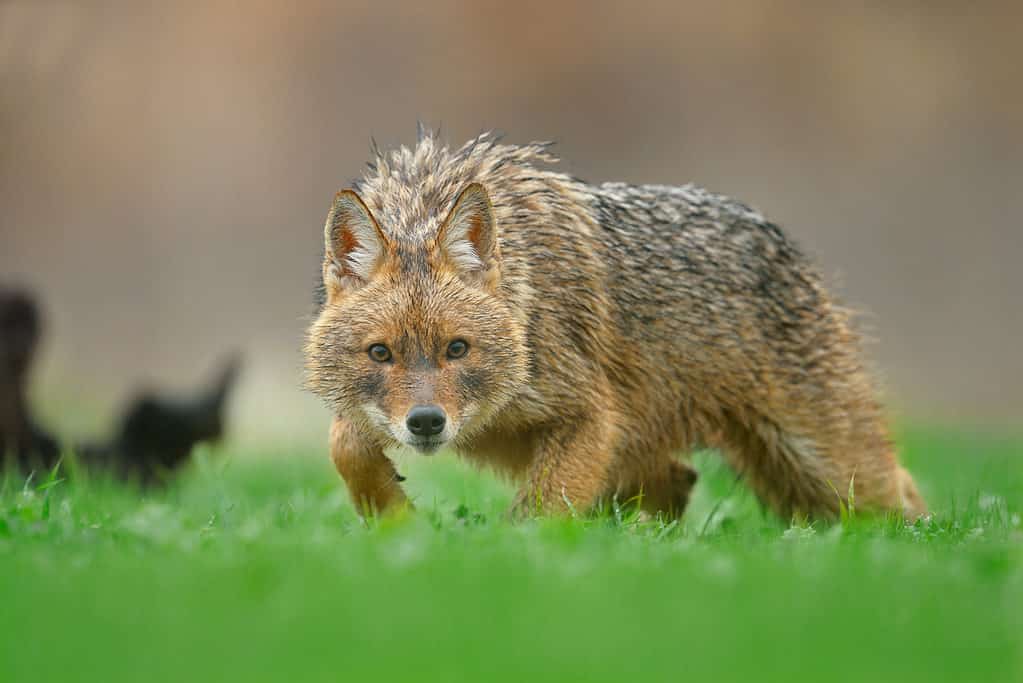Golden Jackal
Canis aureus
Golden jackals are opportunistic omnivores that feed on both plants and meat. However, if need be, they can survive on a solely plant-based diet. They are also one of the 5% of monogamous mammal species.
Advertisement
Golden Jackal Scientific Classification
- Kingdom
- Animalia
- Phylum
- Chordata
- Class
- Mammalia
- Order
- Carnivora
- Family
- Canidae
- Genus
- Canis
- Scientific Name
- Canis aureus
Read our Complete Guide to Classification of Animals.
Golden Jackal Conservation Status
Golden Jackal Facts
- Prey
- Small mammals larger herd animals
- Name Of Young
- pup
- Group Behavior
- Pack
- Fun Fact
- Golden jackals are opportunistic omnivores that feed on both plants and meat. However, if need be, they can survive on a solely plant-based diet. They are also one of the 5% of monogamous mammal species.
- Biggest Threat
- Urbanization and hunting
- Gestation Period
- 65 days
- Age Of Independence
- 1 year
Golden Jackal Physical Characteristics
- Color
- Brown
- Gold
- Tan
- Skin Type
- Fur
- Top Speed
- 40 mph
- Lifespan
- 8 to 16 years
- Aggression
- Medium
View all of the Golden Jackal images!
The golden jackal, also known as the common jackal, is a wolf-like species native to Southeastern Europe, Northeastern Africa, and South Asia. It has a yellow-brown coat which becomes darker in the winter. It has shorter legs, a short tail, an elongated body, and a narrow nozzle. They are an omnivorous species requiring large areas to thrive and hunt for prey.
5 Incredible Golden Jackal Facts
- Golden jackals are exceptionally good at hunting, but if they don’t find prey, they can also survive solely on grass and other vegetation.
- They make yelling, yapping, or howling sounds to communicate with one another.
- Female jackals change the position of their dens every two weeks to protect their little ones from predation.
- Their diet is half plant, half meat, unlike most wolf-like species.
- Contrary to common belief, if hand-raised, golden jackals can be tamed like domesticated dogs.
Golden Jackal Scientific Name
Canis aureus
Scientifically known as Canis aureus, golden jackals are thought to be cousins of the Arabian and African wolf, both of which belong to the same genus as them. They have an uncanny resemblance to the African wolf, Canis lupaster, in African and Middle Eastern countries.
Appearance

Weighing up to 35 pounds, the golden jackal is on the larger side of jackal species.
©Vladimir Kogan Michael/Shutterstock.com
The golden jackal is on the larger side among jackal species but has a smaller tail in comparison to its body size. Golden jackals are about 15 to 20 inches tall, and they weigh between 11 to 35 pounds. The male golden jackals are larger and generally weigh more than the females.
Their fur is rough and relatively short. The golden jackal’s coat is brown and gold in color and may change to become darker in the winter months. They have long, pointy ears. And their nose distinctly protrudes outwards.
Evolution and History
The golden jackal is thought to have evolved from the Arno River dog (Canis arnensis), which was a canine species that went extinct approximately 1.9 million years ago. This was a relatively small ancient canine compared with other ancient canines such as the Epicyon. All canines most likely originated from a prehistoric carnivore called the “Miacis”. Little is known about the Miacis besides that it was a small weasel-sized creature that lived 60 million years ago and was the ancestor of all modern canines.
Behavior
Golden jackals are territorial animals that hunt in groups. Their groups are known as packs. While they are very capable of hunting and have teeth that can hold down any prey, they usually go for smaller animals, such as babies of various herbivores living in their habitat. Their behaviors as a pack are synchronized when hunting prey. If they wish to take down a larger opponent, they do it together as a pack instead of individually, which increases their chances of succeeding against it. They will also occasionally scavenge and eat leftovers from other kills and dead animals.
Members of the same pack may also divide into multiple, smaller packs to cover more land when hunting. They share their food and prioritize any babies or mothers within the herd. The males mark their hunting area or territory with their urine to prevent any foreign golden jackal packs from entering. If other animals arrive in their territory, which could be possible threats, these canines dig holes and bury their meat.
Golden jackals stay nocturnal if they live in an area that humans inhabit. They remain under rocks for shelter during the day and come out at night. However, in other areas, they may be partly diurnal, meaning they are active during the day. Since golden jackals are monogamous, meaning they mate for life, these animals can also be found in pairs and are friendly with one another.
They communicate with one another via several distinct calls, which allow them to locate each other. They howl together as a pack and give out a choral howl if they wish to mate.
Habitat
Golden jackals are well-adapted to dry conditions and have an omnivorous diet that allows them to survive without meat if necessary. They can live in a variety of habitats, from semi-arid desert-like areas to forests, agricultural lands, or semi-urban areas as well. If living around people, they practice a nocturnal lifestyle where they hunt for their food at night. They are found throughout Asia, Europe, and Africa. This goes to say that they can survive in diverse habitats across these three continents.
Diet
Golden jackals are omnivorous species that feed on both meat and plants. They are opportunistic depending on their habitat and can feed on vegetation, berries, fruits, medium-sized livestock, or any animal babies in their habitat. If they see a larger animal making a kill, they may signal to the others in the pack to wait for the animal to finish their meal before they scavenge and eat the remains.
What Eats the Golden Jackal?
Golden jackals are eaten by animals larger than them, such as wolves or leopards that can outrun them. However, if they are hunting in packs, they are likely to be able to fight off predation.
What Does the Golden Jackal Eat?
Golden jackals can feed on any small and medium-sized animals they find in their habitat. This can include but is not limited to mammal babies, birds, and livestock. If any animals are not available, they can still thrive on a plant-based diet, eating fruits, berries, and grass.
Predators and Threats
Possible predators of the golden jackal can be animals that can outrun them, such as leopards, or animals that come in larger packs, such as wolves.
Predators aside, other threats to the population of golden jackals are humans. Since golden jackals raid crops and vegetation for their food and can also feed on livestock, they are prone to human hunting. Another possible threat could be diseases such as rabies and distemper, which have a high mortality rate for golden jackals.
Reproduction
Golden jackals generally practice monogamy, meaning they stay with a single partner throughout their lives. Males mark their territory and fiercely guard their females against other males. There are one or two adults in every pack, known as “helpers,” that stay with the parents to help out with their litter for a year.
Births usually occur throughout the year, depending on the weather, typically in temperate climates in the rainy season. The gestation period of golden jackals is around 63 days A female golden jackal is fertile and can continue having babies for up to 8 years after reaching sexual maturity. Maturity is reached during the first year of their lives.
Golden Jackal Babies
Babies are known as pups and are born after a 63-day gestation period. A litter contains anywhere between 1-9 pups, with an average of 3-5. These pups are born blind and are well cared for by the mother, father, and “helpers” of the pack.
They open their eyes about 10 days after birth and weigh about ½ to 1 pound. Once they reach the 8-week mark, they can fend for themselves and feed on the same diet as their parents. During these 8 weeks, the female changes the location of their den multiple times to ensure the utmost protection of her pups.
Lifespan
The average lifespan of a golden jackal in captivity is 16 years. But, in the wild, golden jackals only live around 8 to 10 years old. As these jackals age, they can face several common ailments. These include, but are not limited to:
- Rabies
- Donovan’s Leishmani
- Parasites and flatworms
- Thorny-headed worms penetrating their bodies
- Intestinal worm
- Ticks
Since some of these diseases can spread to humans, too, it is a good idea to be wary of them.
Population
The current conservation status of golden jackals around the world is Least Concern (LC), and their population is increasing, with high numbers observed in areas with abundant food and water resources around their habitats. The exact number in the world is unknown, but certain numbers are known for various areas around the globe. For example, around 80,000 golden jackals are found in India and another 97,000 to 117,000 all over Europe. They also seem to be expanding towards western and central Europe.
Related Animals…
View all 171 animals that start with GGolden Jackal FAQs (Frequently Asked Questions)
Are golden jackals carnivores, herbivores, or omnivores?
Golden jackals are omnivores, eating both plants and meat, depending on what is readily available to them.
Are golden jackals monogamous?
Yes, they are among the 5% of all mammal species that are monogamous.
Which continents are golden jackals found in?
Golden jackals are found in Asia, Africa, and Europe.
What is the average lifespan of a golden jackal?
The average lifespan of a golden jackal is 16 years in captivity and 8-10 years out in the wild.
Thank you for reading! Have some feedback for us? Contact the AZ Animals editorial team.
Sources
- Animalia / Accessed December 19, 2022
- Animal Diversity Web / Accessed December 19, 2022
- Canid Specialist Group / Accessed December 19, 2022
- Large Carnivore Initiative for Europe / Accessed December 19, 2022
- Wisdom Panel / Accessed December 19, 2022















